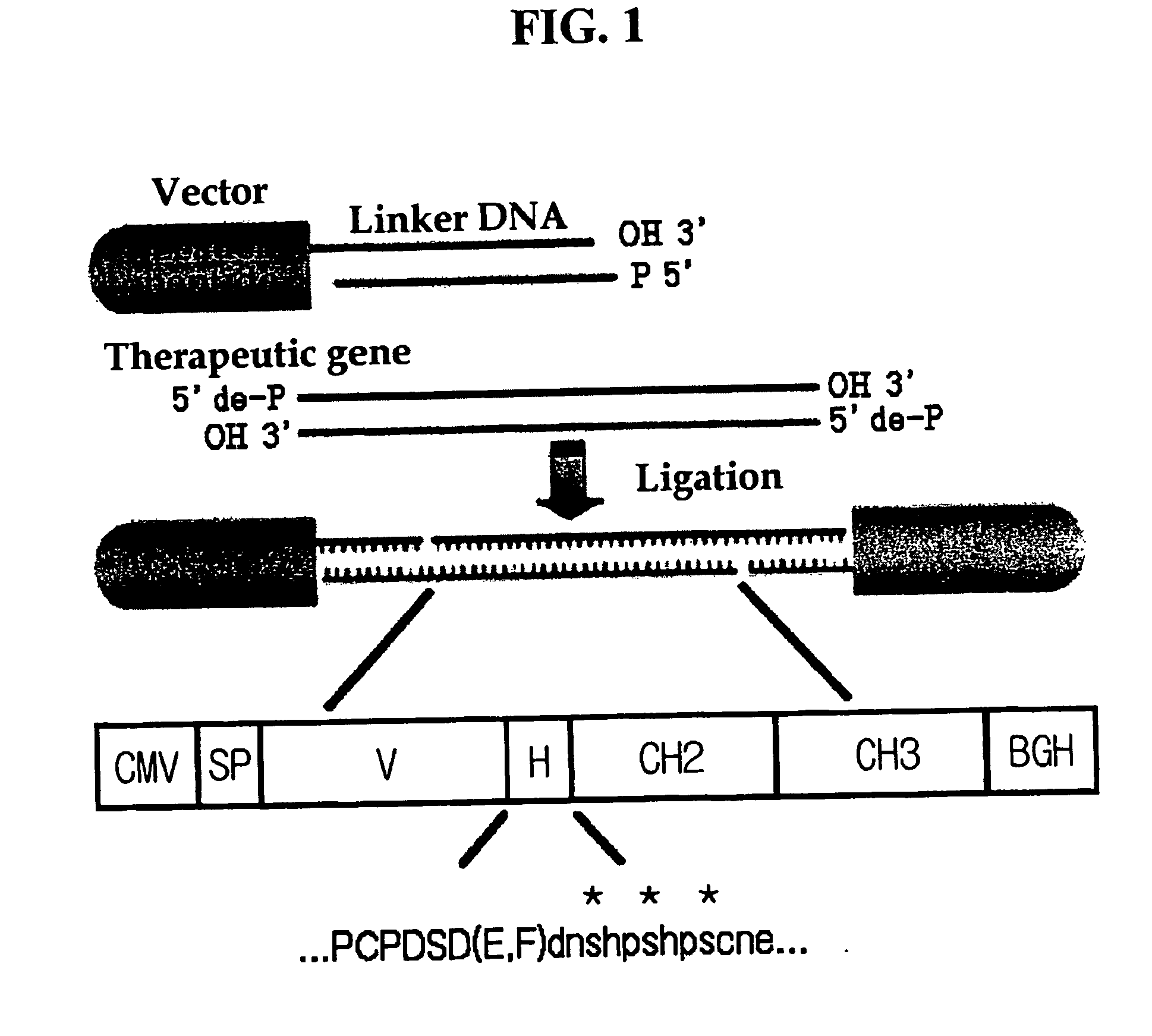Recombinant peptide vector comprising the gene for treatment for autoimmune diseases
- Summary
- Abstract
- Description
- Claims
- Application Information
AI Technical Summary
Benefits of technology
Problems solved by technology
Method used
Image
Examples
example 1
[0073] (1) Amplification of Coding Sequence of Dog CTLA4
[0074] 1.4 ml of CPDA (citrate phosphate dextrose acid) as an anticoagulant was added to 10 ml of venous blood taken from a healthy dog and then subjected to Ficoll-Plaque gradient centrifugation to isolate peripheral blood mononuclear cells (PBMCs). The isolated PBMCs were washed two times with PBS (phosphate-buffered saline), adjusted to 1×106 cells / ml in complete endotoxin-free medium RPMI 1640 (containing 10% fetal calf serum, 50 μl / ml gentamicin, 10 μl / ml concanavaline A), and cultured under 5% CO2 at 37° C. for 4 hours. After the culture, PBMCs were collected by centrifugation and frozen in liquid nitrogen.
[0075] From the isolated PBMCs, total RNA was separated using a Trizol reagent and washed with 75% ethanol, and the RNA pellets were dissolved in DEPC-treated water. 2 μg of the purified mRNA and 1 μl of an oligo (dT) 30 primer were mixed, heated at 70° C. for 2 minutes and cooled by addition of ice. To the mixture, 2...
example 2
Ligation of CTLA4 Extracellular Domain to IgA Fc Fragment
[0079] For the ligation between the CTLA4 extracellular domain and the IgA Fc fragment amplified in Example 1, a forward primer (containing a HindIII restriction enzyme recognition sequence) and a reverse primer (containing an Eco RI restriction enzyme recognition sequence) were set for the amplification of the CTLA4 extracellular domain, and likewise, a forward primer (containing an Eco RI restriction enzyme recognition sequence) and a reverse primer (containing a Xba I restriction enzyme recognition sequence), which are the same as used in Example 1 (2), were set for the amplification of the IgA Fc fragment. Then, PCR was performed with such primers.
[0080] In this case, since a CTLA4 signal peptide was not identified, the signal peptide of human oncostatin M was attached to the 5′-terminal end of the amplified CTLA4, for extracellular secretion. This was achieved by two-step overlapping PCR. The first-step PCR was performe...
example 3
Ligation of Therapeutic CTLA4-Ig Gene to pcDNA 3.1(+)
[0089] The therapeutic CTLA4-Ig gene obtained in Example 2 and a pcDNA 3.1(+) vector were treated with HindIII and XbaI, respectively. Then, the therapeutic gene and the vector were separated and purified on agarose gel and ligated. An E. coli TOP10 strain was transformed with this recombinant vector and selectively cultured.
PUM
| Property | Measurement | Unit |
|---|---|---|
| Length | aaaaa | aaaaa |
| Length | aaaaa | aaaaa |
| Length | aaaaa | aaaaa |
Abstract
Description
Claims
Application Information
 Login to View More
Login to View More - R&D
- Intellectual Property
- Life Sciences
- Materials
- Tech Scout
- Unparalleled Data Quality
- Higher Quality Content
- 60% Fewer Hallucinations
Browse by: Latest US Patents, China's latest patents, Technical Efficacy Thesaurus, Application Domain, Technology Topic, Popular Technical Reports.
© 2025 PatSnap. All rights reserved.Legal|Privacy policy|Modern Slavery Act Transparency Statement|Sitemap|About US| Contact US: help@patsnap.com



